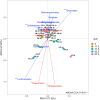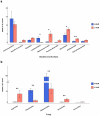Incidence of resistance to ALS and ACCase inhibitors in Echinochloa species and soil microbial composition in Northern Italy
- PMID: 38719860
- PMCID: PMC11078947
- DOI: 10.1038/s41598-024-59856-0
Incidence of resistance to ALS and ACCase inhibitors in Echinochloa species and soil microbial composition in Northern Italy
Abstract
The increasing amount of weeds surviving herbicide represents a very serious problem for crop management. The interaction between microbial community of soil and herbicide resistance, along with the potential evolutive consequences, are still poorly known and need to be investigated to better understand the impact on agricultural management. In our study, we analyzed the microbial composition of soils in 32 farms, located in the Northern Italy rice-growing area (Lombardy) with the aim to evaluate the relationship between the microbial composition and the incidence of resistance to acetolactate synthase (ALS) and acetyl-CoA carboxylase (ACCase) inhibiting herbicides in Echinochloa species. We observed that the coverage of weeds survived herbicide treatment was higher than 60% in paddy fields with a low microbial biodiversity and less than 5% in those with a high microbial biodiversity. Fungal communities showed a greater reduction in richness than Bacteria. In soils with a reduced microbial diversity, a significant increase of some bacterial and fungal orders (i.e. Lactobacillales, Malasseziales and Diaporthales) was observed. Interestingly, we identified two different microbial profiles linked to the two conditions: high incidence of herbicide resistance (H-HeR) and low incidence of herbicide resistance (L-HeR). Overall, the results we obtained allow us to make hypotheses on the greater or lesser probability of herbicide resistance occurrence based on the composition of the soil microbiome and especially on the degree of biodiversity of the microbial communities.
© 2024. The Author(s).
Conflict of interest statement
The authors declare no competing interests.
Figures






References
-
- Yogita Gharde PK, Singh PK, Dubey RP, Gupta PK. Assessment of yield and economic losses in agriculture due to weeds in India. Crop Prot. 2018;107:12–18. doi: 10.1016/j.cropro.2018.01.007. - DOI
-
- Kubiak A, Wolna-Maruwka A, Niewiadomska A, Pilarska AA. The problem of weed infestation of agricultural plantations vs. the assumptions of the European biodiversity strategy. Agronomy. 2022;12:1808. doi: 10.3390/agronomy12081808. - DOI
-
- Délye C, Duhoux A, Pernin F, Riggins CW, Tranel PJ. Molecular mechanisms of herbicide resistance. Weed Sci. 2015;63:91–115. doi: 10.1614/WS-D-13-00096.1. - DOI
-
- GIRE. Gruppo Italiano Resistenza Erbicidi (Italy). http://gire.mlib.cnr.it/.
-
- McElroy J. Vavilovian mimicry: Nikolai Vavilov and his little-known impact on weed science. Weed Sci. 2014;62(2):207–216. doi: 10.1614/WS-D-13-00122.1. - DOI
Publication types
MeSH terms
Substances
Grants and funding
LinkOut - more resources
Full Text Sources
Miscellaneous

